Programmer from overseas leaves change out in public to test Japanese honesty, ends up with more money than he started with.
Ask just about any traveler who’s been to Japan what their impression of the country was, and somewhere within the first three words, you’re likely to hear “safe” (“clean” and “polite” are the other top-three candidates). Japan’s low crime rate has become internationally well-known, but to see for himself just how safe it is here, Canadian-born, U.S.-based programmer Godfrey Chan decided to try a little social experiment.
Chan (who goes by @chancancode on Twitter) recently attended RubyKaigi, a conference for software developers using the Ruby programming language, which was held in Sendai, Miyagi Prefecture, from May 31 to June 2. While there, he decided to leave two 100-yen (US$0.92) coins on a piece of artwork in the lobby of the Sendai International Center, to see if and when someone would swipe them.
But instead of Chan’s research funds disappearing, they actually increased.
https://twitter.com/chancancode/status/1002829089298833408As shown in his video, not only were Chan’s coins left undisturbed, when he checked back on them the next day, they had been joined by a third 100-yen coin!
Chan was amazed by the results, which quickly prompted tongue-in-cheek theories from other Twitter users, such as:
“Darwin, the coins show survival features and are evolving into their environment.”
“The third ¥100 is the second generation. You know what I mean.”
“It’s just common sense. Two happy ¥100 [coins] got married, and produced one more ¥100. Now they are a happy family.”
Jokes aside, Chan’s experiment had other international travelers and foreign residents chiming in with their own experience of how refreshingly respectful Japan is of other people’s property.
https://twitter.com/thomasapowell/status/1003402797520334849Finished my Christmas shopping and took an express train out of Marunouchi eki. I'd left a bag of wrapped presents on a bench. I stared at them as the train pulled away. Being an express, it was about 25 minutes before I could get off. They were right there when I got back.
— Mededitor (@Mededitor) June 3, 2018
My Hasselblad in the street a couple of years ago. I was 2 or 300m away, shooting with the model using another camera. That’s $25,000 worth of gear. Sat there for 25mins. In Ginza. On a busy Saturday. No one touched it. Love this country. pic.twitter.com/FVhcLquFtt
— Alfie Goodrich 📷 (@AlfieJapanorama) June 3, 2018
Lost my wallet, with more than 100,000 yen (at the time, well over $1,000+) on a train. Got the wallet with all the money and untouched credit cards back 8 hrs later.
— Alexis Alvarez (@AlexisinNYC) June 3, 2018
Of course, none of this is to say that Japan is completely crime-free. There’s also the question of whether the coins would have stayed safe for as long if they’d been in a more trafficked, less-scholarly environment than a conference center.
Still, the ability for unattended loose change to survive in the wild for so long is remarkable. As for the extra 100 yen, some speculated it might be connected to the Japanese practice of osaisen, offering coins to gods and spirits. However, osaisen is generally done at shines, temples, or natural areas such as forests and mountains (in keeping with traditional Japanese beliefs about the divinity of nature). It’s not really something you see happen inside of modern, secular buildings, so it seems more likely that someone added the third 100-yen coin on a lark.
Speaking of Japanese cultural values, perhaps the most Japanese response of all was the one asking people to be careful not to damage the artwork.
Your attempt may cause scratch on the sculpture. Don’t place coins but bills pls.
— HARAGUCHI, Toru(原口 徹) (@h_toru) June 3, 2018
And finally, expanding the discussion of crime and safety to include the other side of the coin, law enforcement, one Twitter user said:
https://twitter.com/Raposa_1/status/1003036874007556096He’s definitely got a point, but that means it’s awesome for just about everyone else.
Source: Twitter/@chancancode via Hachima Kiko

 The mesmerizing art of stacking Japanese coins 【Photos】
The mesmerizing art of stacking Japanese coins 【Photos】 In Japan, one yen coins don’t get picked up by strangers in public – they multiply instead
In Japan, one yen coins don’t get picked up by strangers in public – they multiply instead These policemen’s response to a young boy turning in a 50 yen coin he found will warm your heart
These policemen’s response to a young boy turning in a 50 yen coin he found will warm your heart Enormous Buddhist Kannon statue in Sendai shocks visitors with otherworldly looming
Enormous Buddhist Kannon statue in Sendai shocks visitors with otherworldly looming How to protect your umbrella from rampant umbrella thieves in Japan
How to protect your umbrella from rampant umbrella thieves in Japan FUK COFFEE?!? Japanese cafe has a perfectly innocent reason for its startling-looking name
FUK COFFEE?!? Japanese cafe has a perfectly innocent reason for its startling-looking name We save money on crotchless jeans from Japanese brand Beams by making our own
We save money on crotchless jeans from Japanese brand Beams by making our own Japan has nearly 4 million abandoned homes, but where and why?
Japan has nearly 4 million abandoned homes, but where and why? Abe Monjuin: An ancient temple with a connection to stars and astrology…and National Treasures
Abe Monjuin: An ancient temple with a connection to stars and astrology…and National Treasures Yakuza lieutenant arrested in Tokyo for stealing Pokémon cards
Yakuza lieutenant arrested in Tokyo for stealing Pokémon cards Japanese cosplayer creates amazing outfit: Sailor Moon’s transformation sequence!【Photos】
Japanese cosplayer creates amazing outfit: Sailor Moon’s transformation sequence!【Photos】 Redefining Life and Death at the Forefront of Modern Medicine
Redefining Life and Death at the Forefront of Modern Medicine Studio Ghibli unveils new goods that tip the hat to The Cat Returns
Studio Ghibli unveils new goods that tip the hat to The Cat Returns McDonald’s Japan’s new pancake pie is a taste sensation
McDonald’s Japan’s new pancake pie is a taste sensation Beautiful set of 24 Ghibli anime memo pads returns, will have you wanting to take notes by hand
Beautiful set of 24 Ghibli anime memo pads returns, will have you wanting to take notes by hand Foreigner’s request for help in Tokyo makes us sad for the state of society
Foreigner’s request for help in Tokyo makes us sad for the state of society Bad tourist manners at Mt Fuji Lawson photo spot prompts Japanese town to block view with screens
Bad tourist manners at Mt Fuji Lawson photo spot prompts Japanese town to block view with screens One of Japan’s oldest castles now lets travelers spend night on the grounds, drink in its keep
One of Japan’s oldest castles now lets travelers spend night on the grounds, drink in its keep Two things to do, and two things not to do, when leaving a traditional Japanese inn
Two things to do, and two things not to do, when leaving a traditional Japanese inn Japanese city loses residents’ personal data, which was on paper being transported on a windy day
Japanese city loses residents’ personal data, which was on paper being transported on a windy day Studio Ghibli unveils massive T-shirt collection featuring top anime movie characters
Studio Ghibli unveils massive T-shirt collection featuring top anime movie characters Japanese-style accommodation at the new Premium Dormy Inn hotel in Asakusa will blow your mind
Japanese-style accommodation at the new Premium Dormy Inn hotel in Asakusa will blow your mind McDonald’s new Happy Meals offer up cute and practical Sanrio lifestyle goods
McDonald’s new Happy Meals offer up cute and practical Sanrio lifestyle goods New definition of “Japanese whiskey” goes into effect to prevent fakes from fooling overseas buyers
New definition of “Japanese whiskey” goes into effect to prevent fakes from fooling overseas buyers Our Japanese reporter visits Costco in the U.S., finds super American and very Japanese things
Our Japanese reporter visits Costco in the U.S., finds super American and very Japanese things Japanese ramen restaurants under pressure from new yen banknotes
Japanese ramen restaurants under pressure from new yen banknotes All-you-can-drink Starbucks and amazing views part of Tokyo’s new 170 meter-high sky lounge
All-you-can-drink Starbucks and amazing views part of Tokyo’s new 170 meter-high sky lounge More foreign tourists than ever before in history visited Japan last month
More foreign tourists than ever before in history visited Japan last month New Pokémon cakes let you eat your way through Pikachu and all the Eevee evolutions
New Pokémon cakes let you eat your way through Pikachu and all the Eevee evolutions Disney princesses get official manga makeovers for Manga Princess Cafe opening in Tokyo
Disney princesses get official manga makeovers for Manga Princess Cafe opening in Tokyo Sales of Japan’s most convenient train ticket/shopping payment cards suspended indefinitely
Sales of Japan’s most convenient train ticket/shopping payment cards suspended indefinitely Sold-out Studio Ghibli desktop humidifiers are back so Totoro can help you through the dry season
Sold-out Studio Ghibli desktop humidifiers are back so Totoro can help you through the dry season Japanese government to make first change to romanization spelling rules since the 1950s
Japanese government to make first change to romanization spelling rules since the 1950s Ghibli founders Toshio Suzuki and Hayao Miyazaki contribute to Japanese whisky Totoro label design
Ghibli founders Toshio Suzuki and Hayao Miyazaki contribute to Japanese whisky Totoro label design Doraemon found buried at sea as scene from 1993 anime becomes real life【Photos】
Doraemon found buried at sea as scene from 1993 anime becomes real life【Photos】 Tokyo’s most famous Starbucks is closed
Tokyo’s most famous Starbucks is closed One Piece characters’ nationalities revealed, but fans have mixed opinions
One Piece characters’ nationalities revealed, but fans have mixed opinions We asked a Uniqlo employee what four things we should buy and their suggestions didn’t disappoint
We asked a Uniqlo employee what four things we should buy and their suggestions didn’t disappoint Computer overheating? Japanese Twitter suggests using 10-yen coins to cool it off
Computer overheating? Japanese Twitter suggests using 10-yen coins to cool it off Man finds adorable lost “puppy” on roadside in Japan, turns out to be adorable something else
Man finds adorable lost “puppy” on roadside in Japan, turns out to be adorable something else Idol draws such massive crowds at Tokyo college that police can’t guarantee safety【Video】
Idol draws such massive crowds at Tokyo college that police can’t guarantee safety【Video】 Gigantic super-affordable Sailor Moon lifestyle line comes to Japan’s favorite 300 yen shop【Pics】
Gigantic super-affordable Sailor Moon lifestyle line comes to Japan’s favorite 300 yen shop【Pics】 This amazing suit of samurai armor is made of five-yen coins, and you can make your own too【Pics】
This amazing suit of samurai armor is made of five-yen coins, and you can make your own too【Pics】 Eraser stamp of Tokyo Disneyland is almost as amazing as the theme park
Eraser stamp of Tokyo Disneyland is almost as amazing as the theme park Fans share photos of complete pandemonium while waiting to buy Kira Festival 2016 merchandise
Fans share photos of complete pandemonium while waiting to buy Kira Festival 2016 merchandise Travelers’ misguided attempt to earn good luck is damaging Japan’s most famous torii shrine gate
Travelers’ misguided attempt to earn good luck is damaging Japan’s most famous torii shrine gate It’s tempting, but don’t try eating anything made by this artist — you might break your teeth!
It’s tempting, but don’t try eating anything made by this artist — you might break your teeth! Aichi man arrested for impersonating Aichi boy to gain social support
Aichi man arrested for impersonating Aichi boy to gain social support We buy a beginner’s guitar from discount retailer 3 Coins, ask THAT guitar expert if it’s any good
We buy a beginner’s guitar from discount retailer 3 Coins, ask THAT guitar expert if it’s any good Doggy Bread figures are back, still so cute we could eat them up (if they weren’t plastic)
Doggy Bread figures are back, still so cute we could eat them up (if they weren’t plastic) Cinemas in China let audience post comments onto the screen during the movies
Cinemas in China let audience post comments onto the screen during the movies
Leave a Reply